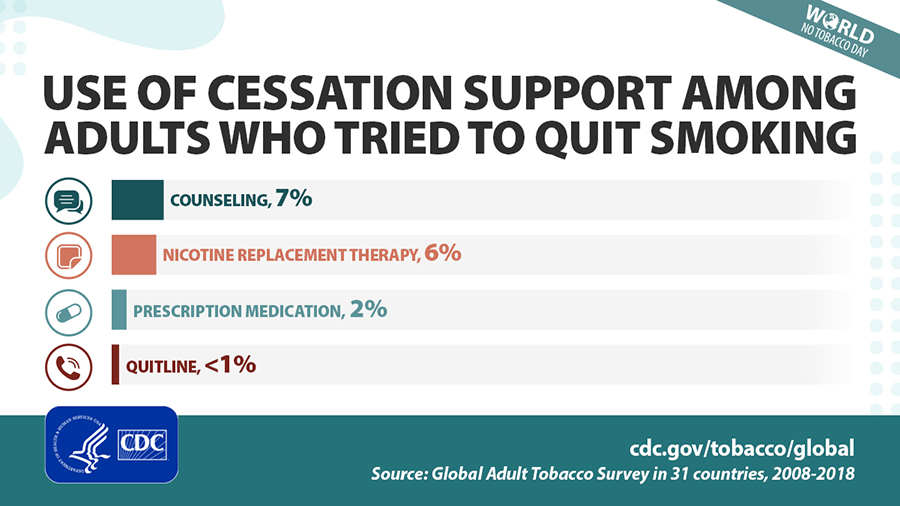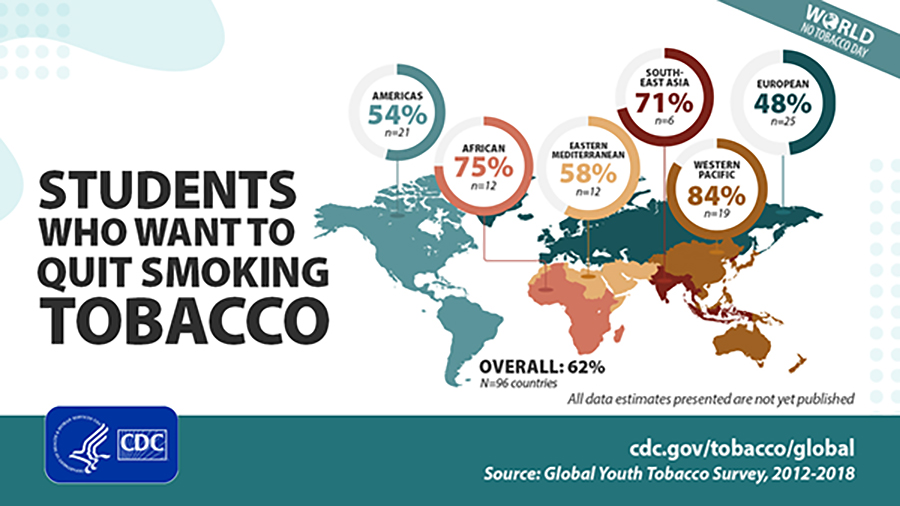Evidence-based cessation services can help make quit attempts more successful
Tobacco is harmful but quitting can help
Tobacco products are harmful. Quitting smoking reduces the risk of cardiovascular disease, chronic obstructive pulmonary disease (COPD), and 12 smoking-related cancers, including cancers of the lung, throat, and liver. It is never too late to stop smoking. While the health benefits of quitting are greater for people who stop smoking at earlier ages, quitting at any age has health benefits.
Adults who smoke tobacco want to quit
Most adults who smoke tobacco want to quit. Data from the Global Adult Tobacco Survey (GATS) show that about 900 million adults aged 15 years or older currently used tobacco products in 32 countries between 2008-2018. Among adults who smoked tobacco, nearly 177 million tried to quit in the past 12 months, with a median prevalence of nearly 40% across 31 countries. Most adults who smoked tobacco who tried to quit tried to do so without assistance, with a median of about 74% across countries.
The use of evidence-based cessation services can help people who smoke quit. However, evidence-based smoking cessation supports are underutilized. In a study of 31 countries, the median adult use of counseling (7%), nicotine replacement therapy (6%), prescription medication (2%) and quitlines (<1%) in quit attempts demonstrate that there are opportunities to improve global use of evidence-based smoking cessation supports (see Figure 1).

Figure 1. Median percentage of smoking cessation support utilization among adults aged 15 years or older who currently smoked tobacco and made a quit attempt in the past 12 months (GATS 2008-2018)
Students who smoke tobacco want to quit
Most people who smoke tobacco start at a young age. Data from the Global Youth Tobacco Survey (GYTS) show that about 14 million young people aged 13-15 years in 157 countries or survey sites across the world use tobacco products between 2006 and 2018. Since 2012, A median of about 6 in 10 young people in 95 countries who currently smoked tobacco reported wanting to quit. The desire to quit varied by region (see Figure 2).

Figure 2. Median percentage of students aged 13-15 years who currently smoked tobacco and wanted to quit, by World Health Organization Region (GYTS 2012-2018)
Evidence-based Strategies for Cessation
To help reduce tobacco use around the world, the World Health Organization (WHO) Framework Convention on Tobacco Control has called for offering support for promoting tobacco use cessation as well as adequate treatment for tobacco dependence. Evidence-based cessation services, including counselling and medication, can help make quit attempts more successful. Population-based support, including education programs and quitlines, can help inform people who smoke of the harms of tobacco use and encourage them to quit by providing information, resources, and support.
Health care professionals play an important role in helping people who use tobacco to quit. CDC’s one-hour Treatment & Beyond online training can help health care professionals better understand smoking prevention and control strategies, including offering their patients advice and assistance to quit for good.
World No Tobacco Day 2021 is the perfect time to join global efforts to help people quit tobacco. Learn more about WHO’s “Commit to Quit” campaign, including more than 100 reasons to quit, and help everyone who uses tobacco to quit today.